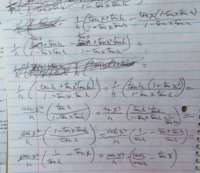allegansveritatem
Full Member
- Joined
- Jan 10, 2018
- Messages
- 962
Here is the problem:
Here is a small selection of what I tried:
I worked on this for most of two hours today without making any headway. I was able to transform the left side into various strange configurations but could not for the life of me get anything that looked like the right side. How to approach this matter?

Here is a small selection of what I tried:

I worked on this for most of two hours today without making any headway. I was able to transform the left side into various strange configurations but could not for the life of me get anything that looked like the right side. How to approach this matter?



